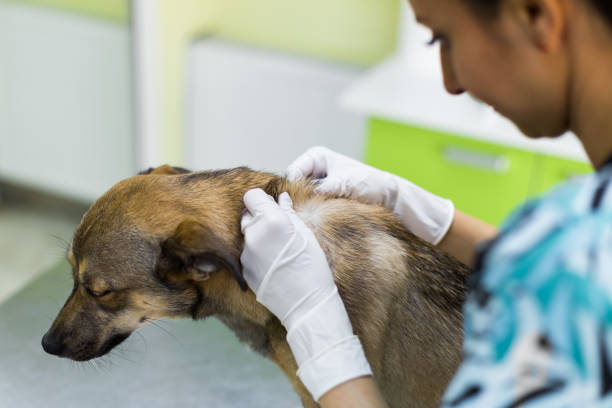How to know if your dog has fleas ?
And what to do ?
What is the best way to tell whether my dog has fleas? You may be perplexed if you observe your dog scratching, tossing her head, biting herself, and then scratching some more. This behaviour might suggest that she is suffering from itching bugs, but how can you be sure? All it takes is a closer look at your dog's skin to see whether he or she has fleas.
Flea Infestation Signs and Symptoms
How can you tell if you have a flea problem? The warning signals are easy to notice. It's possible that your dog is scratching a lot more than normal. It's possible that her skin is inflamed, red, or scabbed. 1 She could bite her flesh so much that she loses her hair. Because itching may be caused by a variety of factors, it's a good idea to search for particular indications of fleas, such as those listed below.
Examine Your Dog's Skin
Examine your dog's skin thoroughly for fleas. Look for little, black insects that aren't as big as ants. Fleas like to congregate in your dog's armpit and groyne areas because they are warm and sheltered. To reveal the skin, part your dog's fur with your fingertips. If you have fleas, you may notice the following symptoms:
- If your dog has been scratching, the skin may seem red and rough.
- You could observe small adult fleas scurrying away or perhaps jumping.
- You could see newly born larvae or pupating larvae cocooned in a cocoon (developing into adults).
Keep an eye out for Flea Dirt.
You may see small black flecks on your dog's skin that resemble finely powdered black pepper when checking his skin. This is flea "dirt" (or faeces), and it might indicate a flea infestation.
Collect any black specks that fall off your dog on a white paper towel to differentiate flea dirt from regular dirt. Using a small amount of water, wet the particles. Flea dirt is visible when they develop a dark reddish-brown hue.
Make use of a flea comb
Start near the skin and work your way through your dog's hair using a flea comb. If your dog has fleas, the comb's fine teeth should catch them. To guarantee they don't survive, place them in a nearby dish of soapy water.
Consider using a light trap
To detect fleas in the house, use a "light trap." Place a small dish of soapy water beside a nightlight on the floor at night. Fleas will flee in the direction of the light and fall into the bowl.
Keep an eye out for tapeworms or flea eggs.
Tapeworms or flea eggs might potentially indicate an issue with your dog. Flea eggs are little white ovals that fall off and land on your bed or carpet.
Tapeworms are parasitic internal parasites that may be contracted by a dog after ingesting a flea. It's possible that your dog has fleas if you observe little white segments that appear like small grains of rice around where he sleeps or sits.You should also discuss tapeworm treatment with your veterinarian.
Do You Have Flea Bites?
Fleas like biting people just as much as they enjoy biting other animals. You may notice a small cluster of little red bites or a succession of itchy bites in a line if you have flea bites. They're usually seen at the ankles or legs, although they can also be found in the armpits, waist, and other places.
Give Your Dog a Shower
Fleas may be removed from your dog's skin and fur using lukewarm water and mild soap. If you're thinking about using a flea shampoo, talk to your vet first. The chemicals in the shampoo may hurt your dog's skin if she has been licking or scratching or is allergic to fleas.
Make use of a flea comb
Flea combs are meant to capture and eliminate fleas and flea filth with their closely spaced teeth. Concentrate on the regions around your pet's neck and tail, because fleas prefer to feed there. To drown any fleas you remove, keep a glass or basin of hot soapy water nearby. Make no attempt to squash the fleas. They're difficult to kill, and they'll often flee before you get a chance to attempt. Repeat at least once a week until there are no more fleas to be found.
Get Rid of the Fleas
They're generally the size of a poppy seed or a sesame seed, and they're brown or reddish brown in colour. If a flea is found on the flea comb, immerse it in hot, soapy water to destroy it. Fleas should not be crushed. They are fast to jump and difficult to kill by hand.
Defend Against Reinfestation
It's far easier to prevent fleas than it is to get rid of them after they've taken up residence on your dog or in your surroundings. The easiest approach to keep fleas out of your house is to use a flea preventive on your dog. Flea collars, insect repellents, topical treatments, sprays, and chews are all options. Many flea preventatives are available over-the-counter, however other medications may require a veterinarian's prescription.
Get Rid of Fleas in Your House
The first step in removing a flea infestation from your home is to remove existing fleas and give your pet a flea preventative. Fleas in your surroundings will be killed by the preventive as they get on your pet. However, because new fleas can emerge at any time during the flea lifecycle, it could take three to four months to completely eradicate an infestation.
Begin by thoroughly cleaning your dog's bedding and soft toys with hot, soapy water. Repeat this process until you no longer have fleas in your home.
Then, in hot water, wash all of your family's bedding, bath mats, throw rugs, and any blankets or pillows your dog prefers to sleep on. Vacuum all of your carpets, linoleum, hardwood, tiled, and upholstered furniture. Immediately dispose of the vacuum bag or dump the canister into an outdoor trash receptacle. Rep these procedures as needed until the infestation is vanished.
Apply a non-toxic flea control spray or fogger to your home or contact an exterminator. Keep your yard's grass and bushes short, and use a non-toxic flea treatment. If your yard's fence has any gaps, fill them in to make it more difficult for rabbits, raccoons, and other flea-carrying creatures to enter.
Vacuum the seats if your dog has been in the car. During flea season, avoid allowing your dog to socialise with other dogs.
Conduct routine inspections
If your pet has a flea problem, use a flea comb on him or her at least once a week until you're sure your home and pet are flea-free.
Allow your pet to self-groom.
Fleas cause cats to clean themselves more. They aren't just scratching. The extra effort, according to researchers, helps cats get rid of fleas. When fleas are present, many dogs brush themselves more frequently. In most instances, this is acceptable. However, if your pet is biting, gnawing, or scratching at itself to the point that you see hair loss or red, irritated, or bleeding skin, you should contact your veterinarian immediately. It's possible that your pet has an illness or is allergic to fleas.
Even if your veterinarian has confirmed that your pet has been attacked by fleas, you may not detect fleas on your pet. They dwell in your carpets, beds, and other household surfaces. They will leap upon pets (and perhaps humans) to eat, although they will typically leave once they have finished.
Seek advice from your veterinarian.
If you're not sure if a product is safe or if you're having problems getting rid of your flea infestation, see your veterinarian. Your veterinarian will be knowledgeable about the most recent treatments and may be aware of issues that are specific to your area.
Fleas may be a real pain, but with the correct methods, you can get rid of them. These pointers will assist you in eliminating your present infestation and preventing re-infestation.




